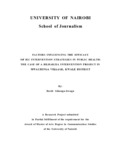| dc.description.abstract | This study assesses the efficacy of an Information, Education and Communication (lEC)
intervention project initiated in Mwachinga Village, Kinango Division, Kwale District in
1996 - to control the spread of schistosomiasis (Bilharzia) in the area. The study was
prompted by the fact that, like many other public health intervention projects in Kenya,
the project may end up having had little or no impact on the target communities.
Secondly, there seemed to have been information gaps as the place has high prevalence
of the disease in Mwachinga village. Bilharzia is a human disease caused by parasitic
worms called schistosomes. It is common in the tropics where ponds, streams and
irrigation canals harbour bilharzia-transmitting snails.
The study was therefore, an attempt to determine the factors responsible for the sustained
high prevalence of the disease. It focused specifically on community knowledge levels,
perceptions and attitudes pertaining to the disease and intervention work, as well as
behaviour change among the residents of Mwachinga village. One of the major
observations was that the presence and spread of bilharzia have largely been attributed to
poor knowledge of the disease and the inappropriate behaviour towards it.
Through a questionnaire administered on a random stratified sample of 200 respondents
(50 men, 50 women, 50 schoolboys and 50 schoolgirls), information was collected and
analyzed by statistical methods. The questionnaire administration was preceded by focus
group discussions with key informants (opinion leaders) of the community in the village,
which has about 200 homesteads.
The results manifest widespread knowledge of bilharzia and infection prevention
methods amongst all the categories interviewed. It was concluded therefore, that the
sustained prevalence of bilharzia in the village is attributable to other factors other than
lack of knowledge. These factors include the community's attitudes towards blood in
urine - the cardinal symptom for bilharzia. There are also other unavoidable
circumstances that make it difficult for the residents to keep off river water.
The study recommends that Mwachinga village residents be taught to view the symptom
of blood in urine (haematuria) with the gravity of the danger it portends, and not as a way
of life. Health education lessons should be regular so as to create the community's
understanding the factors underlying the dynamics of bilharzia infection. To help the
community stay away from the infested river water, the Government should revive the
water kiosk system by pumping safe water from the main water pipe that runs across the
village into the old kiosks, since they are still intact. The number of kiosks should also be
increased to say, 10, for more effective service. | en |

